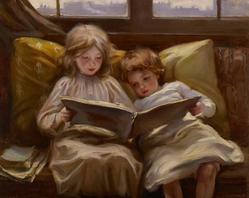
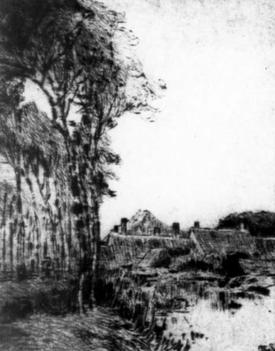

Nicolaas/Nicolaes Wicart (* Utrecht 4 mrt 1748, + Utrecht 5-11-1815), was een Nederlands kunstschilder en tekenaar.
Oostendam - ’t Dorp Oostendam aan de Maas. - Teekening in kleuren door N. Wicart. - 44 X 30 cm.
NB. Er bestaat een boek over deze kunstschilder:
Nicolaas Wicart, tekenaar en porseleinschilder met 500 afbeeldingen (M.W. Heijenga-Klomp), www.hkloosdrecht.nl

'Huig Baas' gaat over de familie van Montfoort die vroeger aan de Oostendam een kleine vlasboerderij had.
In de krant van 1958 staat het volgende over predikant Wentsel:
Ridderkerk
Ds. B. WENTSEL WERD DINSDAG 70 JAAR
Ds. B. Wentsel, predikant van de Gereformeerde Kerk van Ridderkerk, heeft gisteren de leeftijd van de sterken bereikt.
Ds. Wentsel werd op 3 juni 1888 uit een makelaars- en timmermansgezin te Amsterdam geboren, was eerst enige jaren werkzaam op een bankinstelling te Amsterdam en studeerde naderhand nog aan de theologische hogeschool te Kampen, waar hij in februari 1919 zijn kandidaatsexamen deed. Nadat kandidaat Wentsel kort daarop door de classis Zwolle beroepbaar was gesteld in de Gereformeerde Kerken in Nederland werd hij op 16 juni van datzelfde jaar (1919) door prof. dr. J. Ridderbos van Kampen bevestigd als predikant van de Gereformeerde Kerk van Nieuwendam, welke in die dagen nog was gecombineerd met die van Zunderdorp.
Op 12 maart 1922 verwisselde de jubilaris deze kerk met die van Ridderkerk, waar hij werd bevestigd door wijlen ds. A. Schweitzer, toen nog predikant te Amsterdam Noord (Buiksloot).
Ds. Wentsel heeft in de loop der jaren vele bestuursfuncties vervuld en zitting gehad in tal van colleges. Zo was hij o.a. meer dan vijfentwintig jaar voorzitter van de deputaten voor de zending van de particuliere synode van Zuid-Holland Zuidelijk gedeelte en enkele jaren voorzitter van de lectuurcommissie. Thans is hij o.a. nog lid van de Nederlandse Zendingsraad; voor de particuliere synode van Zuid-Holland Zuidelijk gedeelte deputaat ad art. 49 K.O. en voorzitter van de deputaten voor de evangelisatie; in de classis Barendrecht deputaat voor de evangelisatie en kerkvisitator. Verder is hij nog quaestor van de classis Barendrecht en voorzitter van de Stichting provinciaal gereformeerd weeshuis „De Sonnenburgh” voorheen te Middelharnis en thans te Wassenaar; voorzitter van de ring Rijsoord van de Vrije Universiteit; voorzitter van de plaatselijke bioscoopcommissie te Ridderkerk en secretaris van het oud-leden comité 50 jaar jongelingsverenigingen op Gereformeerde Grondslag. Ds. Wentsel werd ook bij herhaling afgevaardigd naar de particuliere synode van Zuid-Holland Zuidelijk gedeelte, waarvan hij meermalen scriba of assessor is geweest.
Van zijn hand verschenen artikelen o.a. in De Macedoniër; Belijden en Beleven en in de Elisabeth Bode en onder de pseudoniën Jacob van Rooij een roman „Huig Baas”. Verder verzorgde ds. Wentsel voor het Gedenkboek 500 jaar Ridderkerk ook een grote bijdrage. Voor zover wij weten is ds. Wentsel thans de oudste, wat betreft da leeftijd, van de dienstdoende predikanten in de Gereformeerde Kerken in Nederland.

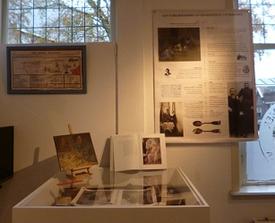
De geschiedenis van beide wijken komt aan de orde en dat levert een paar verrassende zaken op.
Ook zijn er nieuwe verzamelingen van “Rijsoord Schildersdorp” te bekijken. Oostendam levert natuurlijk ook bijdragen met foto’s van o.a. de Korenbloem.
En ter gelegenheid van deze tentoonstelling zal er ook weer een kalender verschijnen, die de donateurs gratis in de bus of op de deurmat zullen vinden.
Dit alles is te zien vanaf 6 november 2024 t/m 4 januari 2025 in Museum Ridderkerk Oudheidkamer aan de Kerksingel 26.

Op zaterdag 16 november is er Open Dag in de Museumschool in Rijsoord. De gemeente onderzoek op dit moment de mogelijkheden voor een nieuwe functie van de Museumschool en wil op deze dag verkennen hoe de omgeving hierover denkt. Daarnaast is er een programma met twee exposities, een atelier en een ‘Verhalenschool'.
De voormalige Christelijke School met de Bijbel opende in 1889 in Rijsoord. Op 15 mei 1940 werd in de school de overgave van Nederland aan Duitsland ondertekend door generaal Winkelman. Tussen 2000 en 2023 heeft de school bekendheid gekregen als Museumschool.
De Nederlandse overheid en samenleving zorgen er samen voor dat de verhalen over de Tweede Wereldoorlog worden doorgegeven. Dit doen ze met herdenkingsmonumenten, musea en herinneringscentra. De Museumschool is een van deze plekken.
Sinds 1 december 2023 is de gemeente de eigenaar van de Museumschool. De school is een belangrijk historisch gebouw. Al in 2021 werd de school een gemeentelijk monument, wat betekent dat het beschermd is tegen sloop. De gemeente wil ervoor zorgen dat deze historische plek bewaard blijft en toegankelijk is voor het publiek als herinneringslocatie.
Toekomst
Samen met bureau COUP onderzoekt de gemeente hoe het verhaal over de capitulatie van Nederland het beste verteld kan worden. Voor het behoud van de plek zijn diverse scenario’s mogelijk, die brengt de gemeente met uw inbreng in beeld. Daarna kiest het gemeentebestuur het beste plan om verder uit te werken.
Op zaterdag 16 november is er van 11.00 tot 15.00 uur een open dag in de Museumschool aan de Rijksstraatweg 101 in Rijsoord. Dan kunt u uw inbreng doen voor de toekomst van het gebouw.
Verhalenschool
Voor de open dag is een programma samengesteld om de geschiedenis van deze plek tot leven te brengen. Zo is er een expositie over de capitulatie en de Tweede Wereldoorlog te zien, een expositie over Schildersdorp Rijsoord met originele schilderijen uit rond 1900, en er is een tekenatelier voor jong en oud.
Van 13.00 tot 15.00 uur wordt in een van de lokalen van de Museumschool een ‘Verhalenschool’ georganiseerd. In de Verhalenschool vertelt Rutger Noorlander over de Nederlandse overgave in Rijsoord. Hij is expert op het gebied van militair erfgoed. Alexandra van Dongen vertelt over het schildersdorp Rijsoord. Zij is kunsthistoricus en achterkleinkind van een Amerikaanse kunstenares.
Het verhaal van Rijsoord wordt gevormd door inwoners van Rijsoord. Iedereen kan een verhaal, oude foto’s of voorwerpen met andere deelnemers delen in de ‘Verhalenschool’. Bijvoorbeeld oude klassenfoto’s, of verhalen van familie over het schildersdorp of het leven tijdens de Tweede Wereldoorlog.

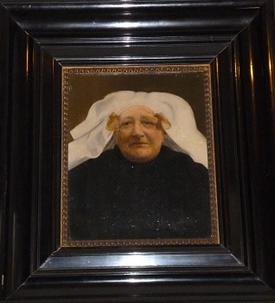
De kunstschilder is niet bekend.
De vrouw is Trijntje de Geus-de Jong, geboren Mijnsheerenland 30-07-1838, overleden Mijnsheerenland 24-4-1906, dochter van Jacob de Jong en Gerritje den Ouden.
Trijntje trouwde op 31-12-1862 met Leendert de Geus, geboren Maasdam 14-01-1837, overleden 10-07-1917.
Trijntje en Leendert hebben tien kinderen.
Trijntje de Jong draagt een rouwkeuvel draagt met effen batist.


"Al heeft men goud en een menigte koralen,
het kostbaarste kleinood zijn verstandige lippen"
De afbeelding komt uit het boek 'Mijn God, wat een dorp' (schets van het dorp Oud-Beijerland, zoals het eens was) van Wim Verhagen met illustratie van Anton Pieck (uitgeverij Semper Agendo BV te Apeldoorn (eerste druk 1973) / Van Holkema en Warendorf (tweede druk 1979)).


SCHILDERSDORP RIJSOORD
IN HET VLAS.
In de zomer werken veel gezinnen in Rijsoord 'in het vlas'.
Ze oogsten de rijpe planten en binden ze vast in schranken.
Zo kan het vlas in de zon drogen.
Uit de zaadbollen van de vlasplant perst men lijnolie.
Van de lange vezels van de stengels wordt linnen gemaakt.
HET HOLLANDSE LICHT.
Het boerenleven en het bijzondere licht in Rijsoord
zijn voor de buitenlandse kunstenaars heel aantrekkelijk.
In Frankrijk hebben zij kennis gemaakt met de Impressionisten.
Het is voor kunstenaar in die tijd mode om naar buiten te gaan
en het echte leven te schilderen.

(bijschrift afbeelding schilderij:)
De vlaswerkers gebruiken de sloten rondom Rijsoord om de stengels zacht te maken.
Dit proces heet roten. Het veroorzaakt wel veel stank.
Het pad langs een sloot is geschilderd door Anna Stanley omstreeks 1895.
(bijschrift afbeelding schilderij:)
Het water voor drinken en wassen wordt ook uit de sloot gehaald.
Rijsoord staat bekend om zijn nette huishouden.
Elke zaterdag poetst men met het slootwater huizen en meubels schoon.
De Duitse schilder Friedrich Kallmorgen schilderde aan de waterkant
meisjes met emmers en een koperen kan.
(bijschrift afbeelding schilderij:)
Friedrich Kallmorgen schildert in 1894 met olieverf de roeiboten onder
de veranda van Hotel Warendorp.
(bijschrift afbeelding schilderij:
Als ze niet op het land werken, dragen de vrouwen van Rijsoord
een linnen keuvel met oorijzers. De Engelse kunstenares Evangeline
Baker, Eve voor intimi, schildert het portret in een medaillon
als ze in 1905 Rijsoord bezoekt.
(bijschrift afbeelding schilderij:)
Het portret van een jonge vrouw in bruidsjurk maakt Anna Stanley
rond 1895, als ze zelf net verloofd is met een officier in het Amerikaanse leger.
[tekst achterkant]
SCHILDERSDORP RIJSOORD
DE AMERIKANEN.
In juli 1887 bezoekt de Amerikaanse kunstenaar
John Vanderpoel, zijn familie in Rijsoord.
Vanderpoel maakt de reis met vier studenten
van de kunstacademie in Parijs.
Het pittoreske dorp bevalt de jongemannen zo goed,
dat ze ook de eerstvolgende zomer terugkeren.
Ditmaal nemen ze tien vrouwelijke medestudenten mee.
EXOTISCHE GASTEN.
Bij de groep vrouwen die in 1888 in Rijsoord verblijven,
zijn ook Ida Gaskell [Haskell] uit Californie en haar vriendin Anna Stanley.
De buitenlandse dames fascineren de lokalen bevolking. Stanley schrijft
dat bij hun wandelingen soms wel honderd kinderen hen volgen.
De buitenlandse kunstenaers logeren in het hotel Warendorp.
De uitbaatster leert van haar gasten "uh leetle Engels" spreken.
Bij de bouw van een nieuw gastverblijf, Pension Noorlander,
is de eer aan Anna Stanley om de eerste steen te leggen.
(bijschrift afbeelding schilderij:)
Het atelier van de kunstenaars bevindt zich
onder een dakraam op de zolder van hun hotel.
Maar de kunstenaars schilderen het liefst
in de buitenlucht: en plein air, zoals dat heet.
(bijschrift afbeelding schilderij:)
In Chicago organiseerde Vanderpoel tekenklassen
in de buitenlucht samen met Alexander Schilling.
Beide mannen hadden een Nederlandse moeder.
De eerste jaren in Rijsoord is Schilling er ook bij.
Aan de oevers van de Waal schets hij zijn boekjes vol.
LIEFDE VOOR RIJSOORD.
In 1892 arriveert de welgestelde Wilhelmina Hawley in Rijsoord.
Hawley komt uit New York en heeft Oscar Wilde nog gekend.
Maar ook zij raakt verknocht aan het kleine dorp aan de Waal.
Ze blijft er heen reizen en geeft schilderlessen aan de andere
buitenlandse kunstenaers die Rijsoord bezoeken.
een jongeman uit de buurt, Bas de Koning, roeit Hawley
en haar klasje regelmatig naar de mooiste plekken langs de rivier.
De kunstenares en de boerenzoon raken verliefd.
In 25 jaar tijd bezoeken zo'n tweehonderd kunstenaars Rijsoord.
De kolonie houdt op te bestaan bij het uitbreken van WOI.
Hawley is inmiddels getrouwd met De Koning en blijft in Rijsoord.
Ze overlijdt in 1958. Ze ligt begraven op Rusthof in Ridderkerk.
(bijschrift afbeelding schilderij:)
Wilhelmina Hawley schildert in 1894
Rijsoordse vrouwen in de lokale klederdracht:
een keuvel met gouden krullen op het hoofd.
Deze panelen zijn ontwerpen door Kelvin Wilson in opdracht van de gemeente Ridderkerk.
De in Rijsoord geschilderde werken bevinden zich voornamelijk in privé-collecties
in Nederland en in de Verenigde Staten.

Koperen melkkannen (en theems (groene trechter)) in de voorraadkelder van het Museum "het Voorhuis":
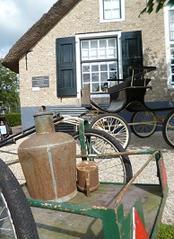
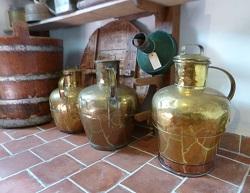

Koperen melkkan in Museum "Dorpsbehoud Papendrecht":
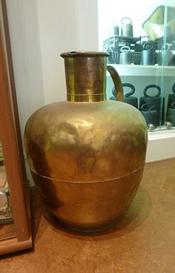

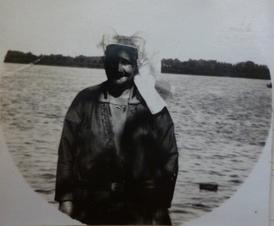
Kaatje van de Griend, geb. Puttershoek 12-04-1872, overl. Puttershoek 30-11-1958, tr. Puttershoek 23-6-1898 Jan van Vliet, geb. Maasdam 28-11-1870, overl. Puttershoek 16-1-1953.

In het 'Register van afgegeven paspoorten met foto's en personalia der paspoorthouders' van Dubbeldam zijn deze foto's
te vinden van vrouwen in Zuidhollandse klederdracht (met muts (keuvel) met krullen):
(1) Hendrina Heiltje van Gemert geb. Dekker, geboren Goudswaard 04-10-1871;
(2) Maaike van der Weijde gehuwd met Arie van Heeren, geboren Dubbeldam 19-12-1;
(3) Cornelia Teeuwen, geboren Dordrecht 27-08-1866 (wed.e D. de Bruijn)

(4) Maria Groeneveld geb. van der Linden, geboren Dubbeldam 19-11-1870;
(5) Lena van der Linden geb. Mol, geboren Dubbeldam 20-09-1884;
(6) Wed. Dirk de Bruijn geb. Cornelia Teeuwen, geboren Dordrecht 27-08-1866;
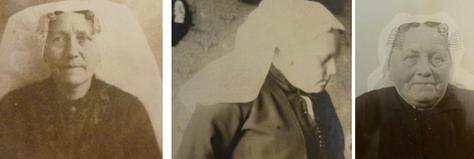

Uit het boek 'foto's van de ingezetenen van Oud-Alblas op 1 september 1941':
(1) Lideweij den Braanker, geb. Sliedrecht 07-01-1861, echtg. G. Jongeneel;
(2) Eigje de Bruin, geb. Oud-Alblas 23-04-1867, echtg. Teunis van Vuuren;
(3) Hendrina Cornelia van den Berg, geb. Oud-Alblas 01-03-1867, weduwe K. Nugteren;
(4) Floortje den Hartog, geb. Oud-Alblas 10-11-1869, weduwe G. Sprang;
(5) Sijgje den Hartog, geb. Wijngaarden 15-11-1863, echtg. P. den Braanker;

(6) Maria Jannigje Heikoop, geb. Oud-Alblas 28-12-1865, echtg. Cornelis Vlot;
(7) Geertje Houweling, geb. Oud-Alblas 06-09-1858, weduwe N. Aantjes;
(8) Cornelia Korteland, geb. Oud-Alblas 20-07-1856;
(9) Neeltje van der Laan, geb. Bleskensgraaf 27-11-1872, echtg. Jan Arie Broer;
(10) Kornelia Muilwijk, geb. Oud-Alblas 02-06-1866, weduwe J. Aantjes;

(11) Annigje Triet, geb. Oud-Alblas 13-06-1871, echtg. Maarten Bouter;
(12) Klazina Triet, geb. Oud-Alblas 16-10-1860, echtg. J. Seton;
(13) Neeltje Verhoef, geb. Oud-Alblas 23-02-1861;
(14) Aartje van Vliet, geb. Oud-Alblas 27-12-1872, weduwe Vlot;
(15) Margrietha Cornelia van der Zijden, geb. Oud-Alblas 02-01-1866, weduwe W.F. de Jong;


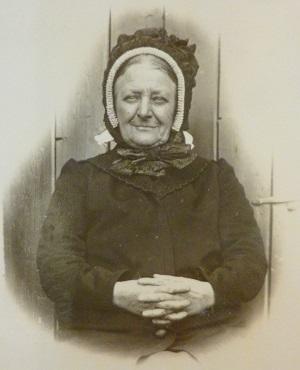
Uit de 'Registers van aangevraagde paspoorten':
Hendrika Grondel, geb. Hardinxveld 03-11-1858, echtgenote van Cornelis den Breejen.
Aangevraagd voor Duitschland op 19 Maart 1926.
Signalement:
haar: grijs
wenkbrauwen: id
oogen: blauw
neus: gewoon
lengte: 1 M 537 cM
Geen bijzondere kenteekenen;


Onder de grote kastanjeboom in de achtertuin van de Museumschool aan de Waal werd donderdag 27 juni de vierde editie van de Summerschool Exhibition geopend.
Tijdens de Summerschool Exhibition leerden veertig leerlingen van het Farelcollege over de geschiedenis van voormalig schildersdorp Rijsoord. ’s Ochtends kregen zij een lezing van Alexandra van Dongen, conservator bij Museum Boijmans van Beuningen en achterkleinkind van een schilder in Rijsoord. Alexandra vertelde dat rond 1880 in de zomermaanden veel schilders uit Parijs naar Rijsoord kwamen om te schilderen. Een van de bekendste schilders is Wilhelmina Douglas Hawley.
’s Middags mochten de leerlingen zelf aan de slag. Gewapend met schilderdoek, verf en kwast schilderden zij de molen, de Waal en de Museumschool. Burgemeester Marco Oosterwijk kwam tijdens de lunch een kijkje nemen bij de jonge kunstenaars. Aan het eind van de middag werden de kleurrijke kunstwerken tentoongesteld in de tuin van de Museumschool. Wethouder Kees van der Duijn Schouten en Alexandra van Dongen bekeken de werken en reikten een prijs uit voor het beste schilderij. De leerlingen namen hun kunstwerken naderhand mee naar school, waar het werk nog beoordeeld werd voor een cijfer.

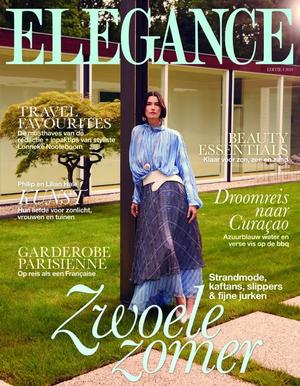
De gevoelens tussen de twee konden niet uitblijven.
Als je aan het Amerikaanse impressionisme denkt, denk je aan Philip Leslie Hale en zijn vrouw Lilian Westcott Hale. Het kunstenaarsechtpaar specialiseerde zich in vrouwen. Elegante dames in bloemrijke tuinen, maar ook moeders en dochters in huiselijke sferen, die Lilian met veel emotie vastlegde.
Passie
Eigenlijk was Philip Leslie Hale (1865-1931) voorbestemd om naar het zeer prestigieuze Harvard te gaan. Als zoon binnen een invloedrijke Amerikaanse familie zou dit de weg zijn om te garanderen dat zijn familienaam op hoog niveau bleef voortbestaan. Maar Philip gaf helemaal niets om status of een respectabele studie. Zijn passie lag bij het tekenen en schilderen en hij wilde dan ook veel liever een kunstopleiding gaan doen. Met tegensputteren gaf zijn vader uiteindelijk toe en mocht hij in 1883 inschrijven aan de School of the Museum of Fine Arts in Boston. Zijn talent viel niet te ontkennen en hij stroomde door naar de Art Students League of New York, waar hij les kreeg van Julian Alden Weir. Deze wekte zijn interesse voor het impressionisme, dat in die tijd vooral in Frankrijk floreerde. Philip wilde zelf graag naar de bron van deze schilderstroming en vertrok in 1887 naar Parijs om verder te studeren aan de École des Beaux-Arts en de Académie Julian. Hij raakte tijdens zijn studietijd goed bevriend met de Amerikaanse kunstschilder Theodore Earl Butler, die later zou trouwen met de stiefdochter van de pionier van het impressionisme, Claude Monet.
Kunstenaarskolonie
Philip en Theodore brachten hun zomers samen als schilderend door, en vonden elkaar helemaal in hun liefde voor de impressionistische schilderkunst. Ze verbleven regelmatig in het dorpje Giverny in Normandië, waar Claude Monet woonde en werkte, en Monet ontpopte zich al snel tot een mentor van de jonge, talentvolle kunstschilder. Philip was niet de enige die hij inspireerde, want onder invloed van Monet ontstond er een hele kunstenaarskolonie van Amerikaanse schilders in Giverny, onder wie Hale en Butler, maar ook Frederick Carl Frieseke, Theodore Robinson en Guy Rose.
Philip voelde zich er thuis, maar miste zijn thuisland ook, en uiteindelijk keerde hij in 1893 terug naar Boston om als leraar aan de School of the Museum of Fine Arts te gaan werken. Daar leerde hij studente Lilian Westcott (1880-1963) kennen, wiens talent eerder al was ontdekt door de Amerikaanse impressionist William Merritt Chase. Chase had haar moeder overgehaald om Lilian zijn leerling te laten worden zodat ze haar technieken kon perfectioneren. Iets wat in die tijd behoorlijk omstreden was: een jonge ondernemende vrouw die onder een oudere mentor ging werken.
Uiteindelijk werd ze aangenomen op de School of Fine Arts in Boston, waar ze Philip ontmoette, die ook vijftien jaar ouder was. Ze hielden na haar studie contact vanwege hun grote passie voor het impressionisme. Gevoelens konden niet uitblijven en in 1902 trouwde Philip met zijn grote liefde en muze, die hij al zo vaak had vastgelegd op het schilderdoek. Zes jaar nadat ze trouwden, kregen ze samen een dochter, Nancy Hale, die later een bekend schrijfster zou worden.
Het hele verhaal over Philip en Lilian in de nieuwe Elegance. Nu in de winkels!

IJselmonde, 13 Maart. Jongstleden Donderdag, en heden op verzoek voortgezet, hebben velen met genoeger kennis gemaakt met den beroemden kunstenaar Prof. Pierre, geboren zonder armen. De man schrijft, teekent, knipt, goochelt enz. op een wijze, welke door vele handen niet kan worder verbeterd.

* Rijsoord, 19 Februari. Vermoedelijk tengevolge van schoorsteenbrand werd jl. Dinsdag de kapitale hofstede van den heer P. Plaizier alhier, benevens een massa gereedschappen (vlas- en landbouw-), eenig vlas, lijnzaad, hooi en stroo in korten tijd een prooi der vlammen; de houding der Rijsoordsche spuitgasten verdient allen lof.
* Het liefhebberij-gezelschap alhier hield jl. Dinsdag avond eene uitvoering. Het tooneelstuk Klopgeesten, in twee bedrijven, werd keurig opgevoerd en gaf ruimschoots bewijzen, dat de jongelui met te vergeefs hadden gearbeid en al mochten de solo’s met piano-begeleiding niet een ieders oor hebben gestreeld, zoo werd dit ruim vergoed door het genot dat men smaakte bij het bal onder directie van den heer W. van Vendeloo te Dordrecht, welke toonde zijn taak geheel meester te zijn. Ook trok het ieders aandacht dat onze jeugdige danderse en danseressen bij het ontvangen van eenige lessen zulke groote vorderingen hebben gemaakt. Wij wenschen het liefhebberij-gezelschap in het beoefenen van beschaafde manieren groot succes.
* Na eene rusttijd van 14 weken, hebben onze visschers nu weder een begin kunnen maken met visschen; ook de scheepvaart zal in ons binnenwater met een paar dagen hersteld zijn. Van harte wenschen wij dat visschers en schippers spoedig het verlorene weer terug zullen winnen.

Gemeentelijke Prentverzameling
Inventarisnummer 552_310321
Beschrijving Eva Verijp, geboren te 's-Gravendeel 17 juni 1800, overleden te Dordrecht 2 maart 1878. Echtgenote van Corn. van der Straten.
Persoon Verijp
Datum of periode 01-01-1840 ‐ 31-12-1849
Auteur Lebret, F.
Beeldtype foto van tekening
Trefwoorden portretten tekeningen
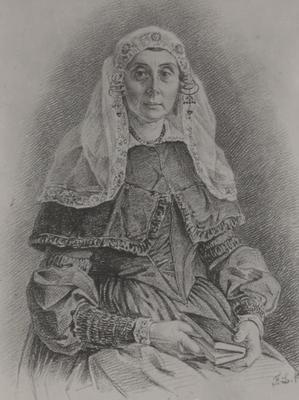

De ontdekking van Holland
Rond 1900 was Volendam een bruisende, internationale kunstenaarskolonie. Meesterverteller Jan Brokken wekt deze buitengewone en onderbelichte episode uit de Nederlandse (kunst)geschiedenis tot leven.
Achter de eenvoudige witte vitrages van het Volendamse Hotel Spaander ligt de kiem van een cruciale periode in de Nederlandse kunstgeschiedenis. De gastvrijheid van uitbaters Leendert en Aaltje Spaander, de levendige avonden en de ateliers op de begane grond bleken vanaf 1881 een magneet voor grote getalen kunstenaars. Uit de hele wereld kwamen ze naar Volendam: ruim 1400 schilders, onder wie zo’n 200 vrouwen. Wat ze aan de Zuiderzee ontdekten waren de typisch Hollandse luchten en het destijds al beroemde Hollandse licht, maar ook verdraagzaamheid en openheid. Toch bleef Spaander als kunstenaarskolonie relatief onbekend – en dat is een kolfje naar de hand van Jan Brokken. Zoals hij stelt in De ontdekking van Holland: je weet altijd te weinig over je eigen land. Opnieuw wekt hij een fascinerende onderbelichte geschiedenis tot leven.
inhoud
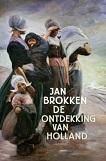
1 Thaulows dood 13
2 Artist kom binne 28
3 De blinde visser 39
4 Een Amerikaanse op de dijk 54
5 Water, twijfel, zeilen en stippels 70
6 Mademoiselle Wilhelmina est délicieuse... 89
7 Begrafenis van een visser 96
8 De moord op Doortje 114
9 Eindeloos hossen, zwaaien, zwieren en draaien 127
10 How is the weather in Volendam? 137
11 De gezusters Zuelzer 147
tweede deel
12 Hille Butter, onbereikbaar dichtbij 157
13 Lucht en licht, de grote tovenaars 164
14 Schetsgrond 170
15 De bekoorlijkheid van het rauwe leven 185
16 Het blauw en het magenta 201
17 De Holland mania 207
18 Wat blijft komt nooit terug 225
19 Gebed voor de doden in het armenhuis 235
20 Een Hollandse vrouw leest 244
21 De processie naar de Genadekapel 256
22 Vrienden van middernacht 271
23 De laatsten aan boord 281
24 Wegvliegende meeuwen 292
Verantwoording en bronnen 305
Illustratieverantwoording 317

nr. 239 William Kay Blacklock (British 1872-1924) - mother and child in a wheatfield.
Oil on cancas, Signed (lower right) 26 x 33 cm ca 1,500-2000 pond
De moeder draagt de kenmerkende witte klompen (met blauw van binnen).
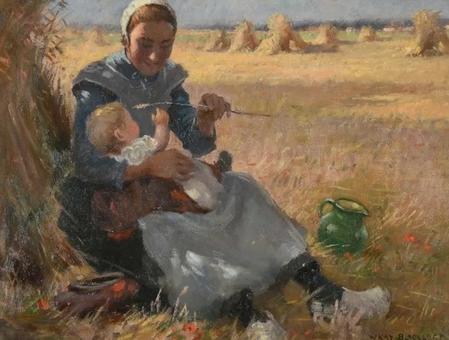

Tekening, gedateerd 1743, van de kerk en pastorie door Aart/Aert Schouman (* Dordrecht 4 maart 1710 - Den Haag 5 juli 1792).
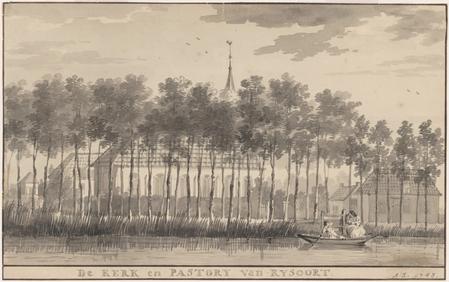
"Een gezicht te Rysoort, met sapverwen, door A. Schouman"
in 'Catalogus van een uitmuntend kabinet teekeningen, ... van wijlen Jan Gildemeester Jansz (1800)'

Koperen melkkan in de kelder van museum Huis van Gijn:
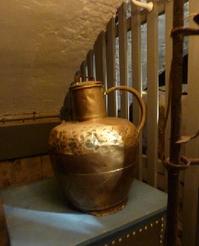

Jonathan5485
Posted on December 24, 2023
The artist I am featuring today is the American painter and watercolourist Wilhelmina Douglas Hawley. She was born on July 13th 1860 in the small coastal town of Perth Amboy, New Jersey. Her father, Peter Radcliffe Hawley was an officer in the coast guard and her mother, Isabella Hawley (née Merritt), a Canadian-born dancer. Wilhelmina’s ancestors were English and Scottish migrants, who moved to the east coast of the United States and Canada in the seventeenth and eighteenth century
... etc

“For Two Years, or Perhaps Forever”; Wilhelmina Douglas Hawley and the Artists’ Colony in Rijsoord
Stories handed down through the generations have a powerful impact. Alexandra van Dongen was always fascinated by the life of her American great-grandmother, an artist who eventually settled in the Netherlands. But Alexandra’s pursuit deepened when she unearthed her ancestor’s passion for an even earlier ancestor, whose actions in the nineteenth century speak to issues persisting in our times and makes for a story that she is keen to pass on to her own sons.
The American artist Wilhelmina Douglas Hawley (Perth Amboy, NJ 1860 – Rijsoord, Netherlands 1958), my great-grandmother, lived a long and interesting life. Her artistic career and family history has fascinated me since I was a young girl. Wilhelmina’s ancestors were English and Scottish migrants, who moved to the east coast of the United States and Canada in the seventeenth and eighteenth century. Wilhelmina was born on the 13th of July, 1860 in Perth Amboy, New Jersey, a small coastal town southwest of New York City. Her birthplace was a gable-fronted brick house at 213 High Street, built in 1854 in Greek Revival style by her grandfather George T. Merritt (St. John’s, Canada 1808 – Rome, Italy 1873). He was the wealthy editor-publisher of the Perth Amboy Journal and built the house for his oldest daughter Isabella. Merritt and his wife Jane Eliza Merritt-Milner (Ryde, Isle of Wight, UK 1810 – New York City, NY 1890) lived nearby, in a colonial brick mansion at what is now 225 High Street.
New York City: Never be discouraged
In 1879, at the age of nineteen, Wilhelmina enrolled in the Cooper Union Women’s Art School, one of the few New York academies open to female students. After one year, she continued her training at the Art Students League (ALS) in New York, a progressive art institution, which was founded in 1875 by a group of artists. While studying to become an artist, she was appointed as the librarian of the ALS. A few years later, Wilhelmina became the League’s first female vice-president. Her teachers and fellow board members included the artists William Merritt Chase, J. Alden Weir, Charles Yardley Turner, and Kenyon Cox. While in New York, Wilhelmina met many visiting international artists and writers. In 1882 the Art Students League was involved in the organization of the American lecture tour of the famous author Oscar Wilde. Wilhelmina’s diary shows that they met a number of times: “I had several long talks about books, art. etc. with Oscar Wilde.” She also accompanied him to a few artist studios. In 1888, she jotted down the quote “Never be discouraged.” These were the reassuring words of visiting Russian painter Vasily Vassilievich Vereschagin (1842-1904) to Wilhelmina when she asked him what the first prerequisite of an artist should be. She was an active member of the New York Water Color Society, the New York Woman’s Art Club (National Association of Women Artists), the Ontario Society of Artists and the Royal Canadian Academy. This extensive network allowed her to take part in several exhibitions.
Paris: “For two years, or perhaps forever”
After spending the winter of 1892-1893 in Bermuda and breaking off her engagement with a mysterious Englishman, Wilhelmina moved to Paris on June 18th, 1892, “for two years, or perhaps forever,” as she wrote in her diary. At the age of 32, she sailed for Europe on the steamer Veendam (I). This was the second time she crossed the Atlantic, as Wilhelmina had joined her family on a European trip in 1872. Upon arrival in Paris Wilhelmina registered at the Académie Julian, one of the two private art academies in the city which admitted female and foreign art students. Yet she remained in the city for only a few days, because the academies were still closed due to the summer holidays. During her transatlantic voyage, Wilhelmina was accompanied by the Dutch-American artist John Vanderpoel (1857-1911) and his wife Jessie Elizabeth Humphreys (1869-1942). Vanderpoel, who was a well-known artist and taught at the Art Institute of Chicago (where Georgia O’Keeffe was one of his students), most likely advised Wilhelmina to spend the summer months at the charming village of Rijsoord near Dordrecht in the Netherlands, where he had founded an artists’ colony in 1886. A considerable number of international artists and art students from Paris flocked to Rijsoord during the summer months. In July 1892 Wilhelmina visited the artists’ colony for the first time. She would return often. During the winter months at the Académie Julian in Paris, Wilhelmina’s art teachers included the French artists Paul-Joseph Blanc (1846-1904), Pierre Fritel (1853-1942), Benjamin Constant (1845-1902), Louis-Auguste Giradot (1856-1933) and Jean-Paul Laurens (1838-1921). In her first year at the Académie Julian, Wilhelmina won the competition for the best composition in figure drawing, in which all male and female students took part.
Shortly before Wilhelmina’s arrival in Paris, the Canadian artist Laura Muntz (1860-1930) had arrived in the French capital in 1891 to take up her studies at the Academie Colarossi. Wilhelmina and Laura met there in 1893. Becoming close friends, they decided to share a studio building and living quarters on 111 Rue Notre-Dame-des Champs. Wilhelmina also posed for Laura several times. In the same year some of Wilhelmina’s artworks were selected for the annual Paris Salon. In addition, one of her Rijsoord paintings, Holland Peasant Girl, was exhibited at the National Academy of Design in New York. This was also the time when she met the American painter James Abbott McNeil Whistler (1834-1903), her neighbor in Paris. From 1892 onwards, Whistler lived in one of the studio buildings on Rue Notre-Dame-des-Champs, just across the street from Wilhelmina’s studio. According to our family tradition, Wilhelmina and Whistler became friends and regularly visited one anothers’ studios, where she also posed for him occasionally.
Rijsoord, the Netherlands
During the summer months between 1892-1900, Wilhelmina regularly traveled from Paris to the French countryside (Normandy and Southern France) and to the Netherlands. She returned to the artist village of Rijsoord many times, where she depicted the local villagers in many oil and watercolor paintings.
When Wilhelmina started teaching art classes at the Parisian Académie Colarossi, she took some of her international students to Rijsoord for summer schools. Rijsoord was ideally situated on an important European highway which connected Paris to The Hague. A local inn, dating back to the 17th century, on a beautiful spot near the river Waal served as a guesthouse to traveling artists. The old inn still stands today and now houses restaurant Ross Lovell. When Wilhelmina first visited Rijsoord in 1892, it was still called Hotel Warendorp. By this time small groups of mostly American art students from Paris visited the artists’ colony, sometimes accompanied by John Vanderpoel. In 1889 Vanderpoel’s cousin Volksje Noorlander-van Nes (1857-1933) and her husband Arie Noorlander (1843-1920) established a hostel called Pension Noorlander in Rijsoord, specifically aimed to provide accommodations to passing artists and art students. As the hostel was located nearby, the inn served as the lively summer headquarters of the artists’ colony during the summer months. The ground floor of the building comprised a living room, a dining room, and a room for drinking coffee. Most of the guest rooms were located on the ground and first floor. The visiting artists used a large space underneath the roof of the building on the first floor as a shared artist studio. Here they could dry their newly-painted canvases and water colors. When rain made it impossible to paint outside en plein air, the artists would work in the upstairs studio.
In 1899, Wilhelmina apparently first encountered the 31-year-old Rijsoord farmer Bastiaan de Koning (1868-1954). They most likely met during a boat trip on the river Waal, as the story goes, as local villagers including De Koning, regularly rowed the artists to their outdoor painting locations. In the summer of 1900 Wilhelmina returned to Rijsoord again and announced her engagement to Bastiaan. They married a year later on December 5, 1901. Another three years later, when Wilhelmina was 44 years old, she gave birth to a daughter, my grandmother, Georgina Florence de Koning (1904-1973), named after Wilhelmina’s aunts. By that time, Wilhelmina had been active in the art world for twenty-five years. Family life did not prevent her from traveling abroad, visit exhibitions or meet her friends in Paris and New York. In 1915, her family in Rijsoord engaged a young housekeeper, Geertrui van Nielen (1895-1981), who became an important supporter in her life. Trui, or Troy, as she was called by Wilhelmina, took care of household matters and looked after Georgy, as Wilhelmina’s daughter was called, when her mother was traveling abroad. In 1930 Georgy married the Rotterdam-born Hans van Dongen. In 1933, at the age of 83, accompanied by her son-in-law Hans, Wilhelmina traveled once more to the United States to take care of family matters and to visit her brother Alan R. Hawley (1864-1938) in New York City, a stockbroker, balloonist and early aviator.
Washington DC
While in the United States, Wilhelmina Douglas Hawley and her son-in-law (my grandfather) Johan Casper (Hans) van Dongen (1907-1983), visited New York City, her birthplace Perth Amboy in New Jersey, as well as the nation’s capital. In Washington DC Wilhelmina proudly showed my grandfather the “Church of the Presidents,” St. John’s Episcopal Church at Lafayette Square, where her grandfather William Dickinson Hawley served as Rector from 1817-1845. He used to live in the church’s parish with his wife and children. The visit made a deep impression on my grandfather and made him eager to find out more about William Hawley’s personal and professional history. During his visit my grandfather decided to continue his career studying theology at Leiden University.
William Dickinson Hawley (Manchester, Vermont 1784 – Washington DC 1845)
Initially, Wilhelmina’s grandfather had chosen a career as a lawyer in New York City, studying under Judge Peter Radcliffe, a prominent attorney. But Hawley also had a strong interest in religious and civil rights matters. He served as a captain in the New York State Militia during the War of 1812, which many critics called “Mr. Madison’s War.” In June 1813, the governor of New York ordered the State Militia to prepare for a British invasion of New York. Subsequently Brigadier General Robert Bogardus, in charge of the Third Brigade of Infantry of the New York State Militia, subsequently issued an order to the commanders of units under his command. On June 10, 1813, Militia Captain William Hawley relayed the order to the company under his command, but added a statement critical of the Madison administration:
In his book St. John’s Church, Lafayette Square. The History and Heritage of the Church of the Presidents (2009), historian Richard F. Grimmitt describes William Hawley’s interesting life’s story. I
The United States being involved in war, whether just and necessary, we as citizens have a right to judge and to express that judgment without fear or molestation. But while we enjoy these rights, we are bound to render obedience to the laws of our country, and to support the Government, at the same time that we condemn the Administration for their weakness and folly in plunging us unprepared into this Quixotic war. From the support hitherto afforded the General Government by its citizens, we have a right to claim of them, and they are bound to give us protection. In consequence of the misconduct of our rulers, this protection has not been afforded us, and we are now called upon to protect ourselves. Painful as this duty may be, I hope and trust that every citizen under my command, will sacrifice with me, on the altar of patriotism, every feeling inconsistent with a full co-operation with the rest of our fellow-citizens; and when the enemy shall approach, to rally round the standard of our country, and in the defense of our liberties, our homes, and our fire-sides, be ready and willing to lay down our lives at the threshold of our country.
Hawley was arrested on June 19, 1813 for “unofficerlike conduct in endeavoring to excite dissention and insubordination among the company” under his command. The local press reported upon it in detail. Hawley admitted authorship of the order to his militia company and prepared a lengthy defense brief, outlining why he was not guilty of the crimes with which he was charged.
The military tribunal denied Hawley permission to introduce this defense brief, but the major New York newspapers printed it in its entirety, taking up nearly an entire page in the New York Commercial Advertiser of July 30, 1813, and in the New York Everning Post of July 31, 1813. Hawley’s defense brief is an extraordinary document for its strong endorsement of the right of freedom of speech by citizen-soldiers, who served in a state militia not under the direct command of the president of the United States, as well as a strong criticism of the decision of the Madison administration to go to war with Great Britain when the United States was militarily unprepared to engage in such a war. At the conclusion of the proceedings, the military tribunal acquitted Captain Hawley of the charges against him without further comment. General Bogardus was outraged by the trial verdict and tried to annull the tribunal’s verdict of not guilty. Despite the wide publicity of Hawley’s trial in New York City, no further record of action against him by military authorities has been discovered sofar. Hawley subsequently resigned his captain’s commission.
Several months later, William Hawley became a candidate for Holy Orders in the Episcopal Church. He was ordained a deacon in the church by the Right Reverend James Hobart, the Episcopal Bishop of New York, in 1814. Thus he began his career as a minister. He soon left New York City for Virginia, taking up the position of Rector of St. Stephen’s Parish in Culpeper County, Virginia. Hawley’s appointment in May 1817 as Rector of St. John’s Episcopal Church in Washington DC kicked off his nearly twenty-eight-year leadership of the newly-built “Church of the Presidents” on Lafayette Square, just across from the White House. During those years, Hawley served four American presidents.
A lesser known side of William Hawley’s life recently came to light in 2020, during the Black Lives Matter protests in Washington DC. As Rector of St. John’s Episcopal Church, Hawley baptized and married many African Americans of all legal statuses. Many of these marriages took place in Hawley’s own home, adjacent to the church, with his wife and family as witnesses. According to the marriage register of St. John’s, Hawley performed weddings for six couples identified as “slaves,” 38 identified as “colored” and two identified as “colored (free).” On January 11, 1828 for example, Hawley married Emmeline Matthews, listed as “colored,” to William Prates, listed as “slave.” When Hawley baptized and married parishioners’ slaves, their masters were at pains to explain to them that the ceremony had not endowed them with freedom in this world. Lafayette Square bears testimony to other aspects of slavery too. It was one of hundreds of sites in the United States where enslaved black people were sold during 250 years of slavery. The nation’s capitol was a major hub for the slave trade. As the tobacco industry in the Upper South fell into decline, so did the need for large numbers of agricultural laborers, according to the White House Historical Association. Many slave owners decided to sell their enslaved workers to dealers based in Washington DC, who imprisoned them in crowded pens for weeks or months before selling them to the Deep South, where the cotton industry had expanded exponentially. Decatur House, which sits on the edge of Lafayette Square, is one of only a few remaining examples of slave quarters in an urban setting. Solomon Northup, author of the 1853 memoir Twelve Years a Slave, was a free black man living in New York before he traveled to DC, where he was kidnapped by slave traders in 1841 and sold into slavery. In 1852, abolitionist Harriet Beecher Stowe (1811-1896) published her world-famous Uncle Tom’s Cabin. She was Wilhelmina Hawley’s cousin, four times removed.
In September 2020, abolitionist and church rector William Hawley was celebrated by Black Lives Matter activists and artists in Washington DC. They were invited by the current rector Rev. Robert Fisher, partnering with DowntownDC BID and the P.A.I.N.T.S. Institute (Providing Artists with Inspiration in Non-Traditional Settings), to create murals outside of the historic St. John’s church and the church’s parish house, to promote racial justice in response to the death of George Floyd at the hands of the police. The church’s parish house at 1525 H Street, NW once was home to Rev William Hawley and his family, who lived there from 1817-1845. Artist Demont Peekaso Pinder honored William Hawley with an extraordinary portrait painted on plywood, covering the parish front door. Next year I am planning to visit Washington DC again, this time accompanied by my twin sons Jonathan and Johannes Gaba, who were born in Rotterdam in 2001, in search for more information about our ancestors.
About the author
Alexandra van Dongen (Leiden, 1961) is trained as a museologist (Reinwardt Academy) and art historian (Leiden University), and has been working at the Boijmans Van Beuningen Museum in Rotterdam since 1986. Since 1992 she continued her career at the museum as curator of historic design, specializing in material objects as artists models. Her most recent publication is Dichter bij Vincent. Alledaagse gebruiksvoorwerpen in het werk van Vincent van Gogh (Gorredijk: Sterck & De Vreese, 2022). Alexandra is currently working on her forthcoming publication The Tangible World of Johannes Vermeer (September 2025). Since 2018 Alexandra is involved in an ongoing research project about the history of colonialism and slavery of the city of Rotterdam. In 1995 Alexandra initiated and curated the traveling exhibition One Man’s Trash is Another Man’s Treasure: The Metamorphosis of the European Utensil in the New World, which reflected on the impact of European tradegoods on Native American culture.
... etc

Miss Wilhelmine D. Hawley, from New York, exhibits an important picture, entitled "In Fairyland," representing two children, life size, leaning on a table, absorbed in an old book. The light comes over the children’s heads, and is reflected from the open book on to their faces.
In the water color section Miss Hawley contributes a charming picture of a young mother and her babe in a garden of roses, catalogued "Well Beloved."
"In Fairyland" zal heel veel lijken op "Interesing Story" uit 1898, van haar vriendin Laura Muntz.
